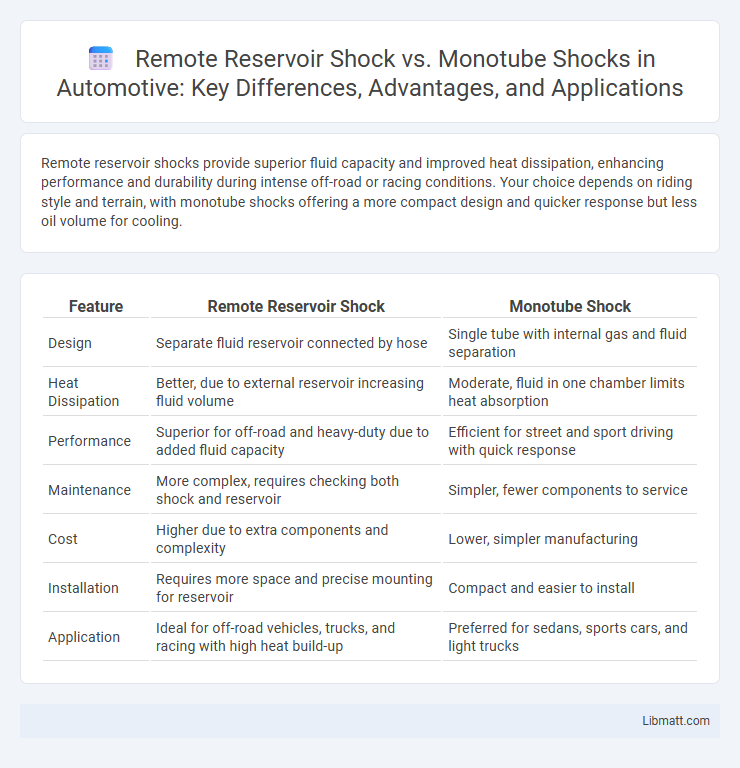Remote reservoir shocks provide superior fluid capacity and improved heat dissipation, enhancing performance and durability during intense off-road or racing conditions. Your choice depends on riding style and terrain, with monotube shocks offering a more compact design and quicker response but less oil volume for cooling.
Table of Comparison
| Feature | Remote Reservoir Shock | Monotube Shock |
|---|---|---|
| Design | Separate fluid reservoir connected by hose | Single tube with internal gas and fluid separation |
| Heat Dissipation | Better, due to external reservoir increasing fluid volume | Moderate, fluid in one chamber limits heat absorption |
| Performance | Superior for off-road and heavy-duty due to added fluid capacity | Efficient for street and sport driving with quick response |
| Maintenance | More complex, requires checking both shock and reservoir | Simpler, fewer components to service |
| Cost | Higher due to extra components and complexity | Lower, simpler manufacturing |
| Installation | Requires more space and precise mounting for reservoir | Compact and easier to install |
| Application | Ideal for off-road vehicles, trucks, and racing with high heat build-up | Preferred for sedans, sports cars, and light trucks |
Introduction to Remote Reservoir Shock and Monotube
Remote reservoir shock absorbers feature an external fluid chamber connected to the main shock body, allowing greater fluid capacity and improved heat dissipation for enhanced performance during extended or extreme riding conditions. Monotube shocks integrate the oil and gas in a single, sealed tube, providing consistent damping response and better heat management in a compact design suitable for a variety of vehicles. Your choice between remote reservoir and monotube shocks should consider factors like ride type, terrain, and performance needs to maximize suspension efficiency.
How Remote Reservoir Shocks Work
Remote reservoir shocks improve Your off-road or performance suspension by separating the shock body from the fluid reservoir, increasing oil capacity and heat dissipation. This design reduces shock fade during extended use by maintaining consistent damping performance through better thermal management. The connected reservoir uses a high-pressure hose, allowing for increased fluid volume and enhanced airflow to keep the shock cool under demanding conditions.
How Monotube Shocks Function
Monotube shocks function by using a single tube filled with hydraulic fluid and a high-pressure gas chamber separated by a floating piston, allowing for rapid heat dissipation and consistent damping performance. The design enables direct contact between the shock piston and fluid, providing precise control and improved responsiveness on various terrains. This contrasts with remote reservoir shocks, which utilize an external fluid chamber to increase oil capacity and cooling but introduce additional complexity and weight.
Key Differences Between Remote Reservoir and Monotube Shocks
Remote reservoir shocks feature an external chamber that increases fluid capacity and improves heat dissipation, enhancing performance in demanding off-road or racing conditions. Monotube shocks have a single tube design where the gas and fluid are separated by a floating piston inside the same body, offering precise damping and quicker response. Understanding these key differences helps you choose the right shock absorber for your vehicle's specific suspension needs.
Performance Comparison: Off-Road Capabilities
Remote reservoir shocks offer superior heat dissipation and consistent damping performance over extended off-road use, making them ideal for rough terrains and long trail rides. Monotube shocks deliver responsive handling and predictable performance but may experience heat fade under extreme conditions. Your off-road vehicle's performance benefits from remote reservoir shocks when tackling challenging trails that demand sustained shock absorption and durability.
Heat Dissipation and Fade Resistance
Remote reservoir shocks offer superior heat dissipation due to their larger fluid capacity and external reservoir design, which allows for better cooling during intense driving conditions. This enhanced thermal management significantly reduces the risk of shock fade, maintaining consistent damping performance over prolonged use. In contrast, monotube shocks have limited fluid volume and more compact heat dispersion, making them more susceptible to heat buildup and performance degradation under extreme stress.
Durability and Maintenance Considerations
Remote reservoir shocks offer enhanced durability by effectively dissipating heat, reducing the risk of shock fade during intense use, and extending overall lifespan compared to monotube shocks. Maintenance is generally more involved due to the complexity and additional components, such as the external reservoir and hose connections, which may require periodic inspection and service. Monotube shocks are simpler in design, making them easier and less costly to maintain but may be less durable under extreme conditions due to their integrated reservoir and limited heat dissipation.
Ride Quality and Handling
Remote reservoir shocks provide superior ride quality and handling by improving heat dissipation and fluid control, which reduces fade and maintains consistent damping performance during extended use. Monotube shocks offer responsive handling through a single-tube design but can suffer from heat build-up, leading to decreased performance under demanding conditions. Off-road and high-performance vehicles often favor remote reservoir shocks for their enhanced ability to deliver smoother rides and better traction control over rough terrain.
Cost and Installation Factors
Remote reservoir shocks generally come with higher initial costs due to additional components and more complex installation requirements, including mounting space for the reservoir and extended hose routing. Monotube shocks offer a simpler, more cost-effective installation as they consist of a single sealed unit with straightforward mounting, reducing labor and compatibility issues. Your choice should consider budget constraints and the ease of installation based on your vehicle's setup and intended use.
Choosing the Right Shock Absorber for Your Vehicle
Selecting the right shock absorber requires understanding the distinct benefits of remote reservoir shocks and monotube designs. Remote reservoir shocks provide enhanced cooling and increased oil capacity, making them ideal for off-road and heavy-duty applications where prolonged damping performance is crucial. Monotube shocks offer quicker heat dissipation and a more responsive ride, suitable for street driving and moderate off-road use.
remote reservoir shock vs monotube Infographic

 libmatt.com
libmatt.com